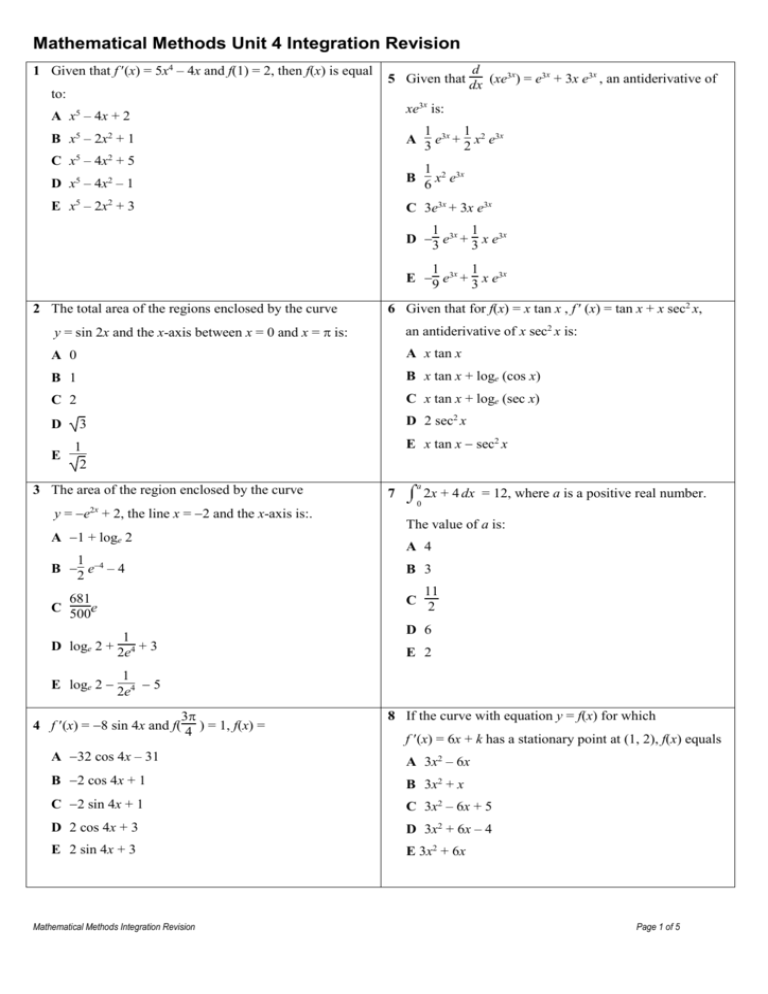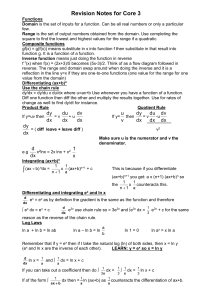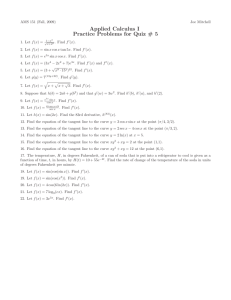Integration Revision With Answers
advertisement

Mathematical Methods Unit 4 Integration Revision 1 Given that f (x) = 5x4 – 4x and f(1) = 2, then f(x) is equal to: A x5 – 4x + 2 B x5 – 2x2 + 1 C x5 – 4x2 + 5 d 5 Given that dx (xe3x) = e3x + 3x e3x , an antiderivative of xe3x is: 1 1 A 3 e3x + 2 x2 e3x D x5 – 4x2 – 1 1 B 6 x2 e3x E x5 – 2x2 + 3 C 3e3x + 3x e3x 1 1 D e3x + x e3x 3 3 1 1 E 9 e3x + 3 x e3x 2 The total area of the regions enclosed by the curve 6 Given that for f(x) = x tan x , f ′ (x) = tan x + x sec2 x, y = sin 2x and the x-axis between x = 0 and x = is: an antiderivative of x sec2 x is: A 0 A x tan x B 1 B x tan x + loge (cos x) C 2 C x tan x + loge (sec x) D 3 E 1 2 D 2 sec2 x E x tan x sec2 x 3 The area of the region enclosed by the curve y = e2x + 2, the line x = 2 and the x-axis is:. A 1 + loge 2 1 B 2 e4 – 4 C a 0 The value of a is: A 4 B 3 11 C 2 681 e 500 1 D loge 2 + 2e4 + 3 E loge 2 7 2x + 4 dx = , where a is a positive real number. D 6 E 2 1 5 2e4 3 4 f (x) = 8 sin 4x and f( 4 ) = 1, f(x) = 8 If the curve with equation y = f(x) for which f (x) = 6x + k has a stationary point at (1, 2), f(x) equals A 32 cos 4x – 31 A 3x2 – 6x B 2 cos 4x + 1 B 3x2 + x C 2 sin 4x + 1 C 3x2 – 6x + 5 D 2 cos 4x + 3 D 3x2 + 6x – 4 E 2 sin 4x + 3 E 3x2 + 6x Mathematical Methods Integration Revision Page 1 of 5 y 9 The graph with equation y = k (x2 – 1) is shown. The area of the shaded region is equal to 20. The value of k is equal to: A –30 B –15 0 2 C 3 1 x y = k(x2 – 1) D 15 E 30 10 The graph with equation y = x2 for x > 0 is shown. When the area between the graph and the x-axis for 0 ≤ x ≤ 3 is approximated by using the upper rectangles and the partitioning shown, the area is: A 6 B 9 1 C 92 D 10 E 14 11 The graph with equation y = f(x) is shown. The total area of the shaded region is equal to: A B C – D 3 f(x)dx 0 1 0 f(x)dx – 1 0 3 f(x) dx 1 f(x)dx + f(x)dx – 1 1 3 0 0 E – f(x)dx + 1 0 3 f(x)dx f(x)dx 3 0 f(x)dx 12 The graphs with equations y = x3 and y = 8 are shown. The area of the shaded region is equal to: A 64 – B 8 0 C 16 D E 8 0 8 0 8 0 x3dx x3dx – 64 2 0 x3dx x3dx – 16 8dx – 8 0 x3dx Mathematical Methods Integration Revision Page 2 of 5 13 Given that a5 x4dx = 5 , then a 0 0 –a x4dx is equal to: 15 Given dy dy = ae-x + 2 and that when x = 0, = 5 and y = dx dx A 0 1, when x = 2, y = a5 B 5 3 A e2 + 2 2a5 C 5 3 B e2 + 4 a5 5 3 C e2 + 8 D – D 3e2 + 4 2a5 E – 5 E 3e2 + 8 14 The approximation to x2 + 1 dx, by using the 2 0 rectangles OABC and CDEF with vertices O(0, 0), A(0, 1), B(1, 1), C(1, 0) and C(1, 0), D(1, 2), E(2, 2), F(2, 0), is: 14 A 3 B 3 C 4.67 D 2 E 4 Answers 1 E 2 C 3 D 4 D 5 E 6 B 7 E 8 C 9 A 10 E 11 B 12 C 13 B 14 B 15 C Short-answer questions (technology-free) 1 Find an antiderivative of each of the following: ( a cos 3x + b 6 ) 1 sin 4x 3 c e4x + 6x d 6 sin 3x – 4e–2x+2 e cos (2x + 2) + 4 ( f sin 4x + 4 ) 1 g 3x + 4 Mathematical Methods Integration Revision Page 3 of 5 2 Find f(x) if f (x) = ex/4 and f(0) = 4 3 The graph of the function f: R R , f(x) = e2x – 3ex + 2 is shown below: y y=2 y = f(x) 0 c x The graph of f passes through the origin and the point (c, 0). a Find the exact value of c. b Find the exact values of the coordinates of the turning point of the graph of f. c Write an appropriate definite integral which determines the area of the region bounded by the graph of f and the xaxis and find the exact value of this area. 4 a Differentiate x cos 2x and hence find an antiderivative of x sin 2x. b Evaluate 2 0 x sin 2 x dx. 5 Calculate the exact area enclosed between the curve y = 3 cos (2x) – 3 and the x-axis between the lines x = and x = 6 a Differentiate loge (x3 + 1) with respect to x. b Hence or otherwise evaluate 1 0 3x 2 dx. x3 1 7 The curve with equation y = f(x) has a gradient function with rule f (x) = 4x2 + k, where k is a constant, and has a turning point with coordinates (–1, 6). Find: a the value of k b the rule f(x) 8 Given that a 1 b 5 c 5 0 0 1 1 0 f (x ) dx = f (x ) dx + 1 5 5 1 f (x ) dx = 6, evaluate each of the following: f (x ) dx f (x ) dx [2 f ( x) 5] dx Mathematical Methods Integration Revision Page 4 of 5 9 Find the area of the regions bounded by the graph of y = cos x, the lines with equations x = and x = and the x-axis. 6 3 [ ] x 10 The graph of y = 3 cos 2 is shown for x 0, π . y A 0 B x a Find the equation of the straight line which passes through points A and B. b Find the area of the shaded region. Analysis Question A country road runs alongside an east-west railway line. The road then slowly veers away from the railway line before turning back at point A and eventually crossing over the line. The railway line can be modelled by the straight line with equation y = 4 and the road by the curve with equation y e2x 5ex 4 , where each unit on the x and y axes represents one kilometre. a b c d Show that the road passes through the origin. Find the exact coordinates of the second point where the road crosses the x-axis. Find the exact coordinates of the point where the road crosses the railway line. Use calculus to find the exact coordinates of A and hence state how far A is south of the railway line in kilometres, correct to 2 decimal places. A farmer wishes to farm the land bounded by the road and the x-axis. e Use calculus to find the exact area of this land. The farmer approaches the local council with a proposal to purchase this land. The councillors, who are keen to sell a much larger region, will not allow him to purchase the land that he proposes; instead they offer him all of the land enclosed by the road, the railway track and the line with equation x = –3 for the bargain price of $50 000 per square kilometre. f i Write down a definite integral whose value will give the cost to the farmer of accepting the councillors’ offer. ii Hence find the amount, to the nearest $100, that the farmer will need to pay to the council if he accepts their offer. [1 + 2 + 2 + 4 + 3 + 3 = 15 marks] Mathematical Methods Integration Revision Page 5 of 5 Extended-response questions Consider the family of functions fa: [0, ) R, defined by fa(x) = x a x2/3 where a is a real number, a > 0 y y = fa(x) x a fa (c) = 0 and c 0. Express c in terms of a. b Determine intervals on which fa is a decreasing function and the intervals on which fa is an increasing function. c Find the equations to the tangents to the graph of fa at the point where the graph of fa crosses the x-axis. What can be said about these tangents? d What is the range of fa? e Find the exact value of the area of the shaded region. Mathematical Methods Integration Revision Page 6 of 5 Answers to Chapter 12 Test B Answers to short-answer (technology-free) questions 1 π 1 a 3 sin(3x + 6) 1 b –12 cos 4x 1 c 4 e4x + 3x2 d –2 cos (3x) + 2e–2x + 2 1 e 2 sin (2x + 2) + 4x 1 π f –4 cos (4x + 4 ) 1 g 3 loge (3x + 4) 2 f(x) = 4e x/4 3 a loge 2 3 1 b (loge ( ), – ) 2 4 c – 0 e – 3e x 2 dx, 2 – 2 loge2 4 a cos (2x) –2x sin (2x), 3 loge 2 2x sin(2x) – 2x cos (2x) 4 π b 4 5 6π 3x2 6 a x3 + 1 b loge (2) 7 a k = –4 4 10 b f(x) = 3x3 – 4x + 3 8 a 0 b 12 c 32 9 3 1 2 3 10 a y = –π x + 3 3π b 6– 2 Mathematical Methods Integration Revision Page 7 of 5 Answers to extended-response questions a c = a3 8a3 8a3 b decreasing on (0, 27 ) and increasing on ( 27 , ) 1 c y = (x – a3), all are parallel 3 4a3 d [– 27 , ) a6 e 10 Mathematical Methods Integration Revision Page 8 of 5







